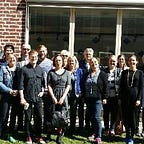#punktfarsta: A hyperlocal storytelling project in Stockholm
The city of Stockholm has millions of stories that are waiting to be told by its citizens. Every place has a story: the place where you lived as a child, met your first love or cried over lost love. In this post the team at Stockholm City Museum explain how they are building the foundation for a storytelling project in Farsta, a suburb of Stockholm.
Farsta is a big district in Stockholm where each neighborhood has its own unique character and identity. The Stockholm City Museum wants to engage both the residents and visitors in this district to share their stories. Our goal is to capture the diversity of Farsta and raise interest in its history among current and future residents. This is why it is important that the community becomes co-creators of this new source material.
We regularly posts historic photographs of Stockholm from our collections on Facebook. People tend to spontaneously respond to them by sharing their personal experiences connected to a particular building, area or time period.
Very often one comment leads to another and soon we have a thread of conversation. In this respect, we have noticed that Facebook is good for information in the moment, but this content is easily lost in the fast paced timelines.
Facebook is good for information in the moment, but this content is easily lost.
We wanted to find a better way to collect and spread these stories. To offer people connected with Farsta a dedicated and sustainable platform for sharing photos and videos from places that have meaning to them. After looking at a variety of open source platforms we settled on using History Pin, which will be a digital map with placable location pins.
Collaboration is at the heart of this project. As a museum, we will take part by initiating posts with historic pictures and texts. In the following weeks we will kickstart the project publicly by posting stories connected to Farsta combined with content from our own collections. Visitors can also explore our huge database of digital documents and photos, and use them as they like to tell their stories with hashtag #punktfarsta.
A million stories:
The roadmap to an open and inclusive museum
#PunktFarsta is part of the museum’s larger collecting and documentation projects in Farsta during 2015. We want to increase our presence in places outside the museum building, raising the possibility for more voices to be heard and for more people to contribute to the cultural heritage through their personal memories and experiences. Punkt Farsta will have access to the main project’s resources in terms of on-site staff and partners such as the local library and various associates. During the year, we will arrange activities in Farsta based on the stories shared on Historypin.
We want to increase our presence outside the building, raising the possibility for more voices to be heard.
We eagerly anticipate the stories that will be shared as part of our project. Perhaps there are a million stories to be shared. Here a little snaphot of the images and content we will share.
What do you see?
The family and the birthday cake!
Here’s an image from our photo collection of a group of people enjoying a sunny day in the Farsta center, which had just opened on October 23, 1960. A father is taking photos of his wife and child by one of the water fountains, crafted by the artist Per-Erik Willö. In the background you can see two big department stores. The left one contained a grocery store and bank with facade made of teak, also referred to as the Birthday cake because of the 136 lamps decorating the top of the building. To the right is the retail chain Kvickly covered with molded and enamelled aluminum plates, known as the waffle. What else do you see?
This blog post has been written by the team from Stockholm City Museum working on the Digital Identity Development programme in Sweden. It has been edited by Johan Lindblom who is a consultant and facilitator on the programme. To find out more please click here.
